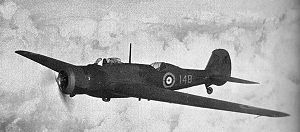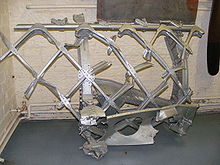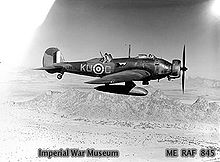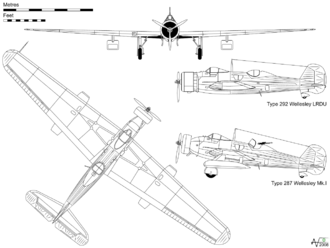Vickers Wellesley Video - Drawings, diagrams and World War II Pictures
|
|
|
|
Vickers Wellesley
Wellesley

Picture - Type 292 of the Long-Range Development unit. Unlike production Wellesleys, the engine cowling is blended with the fuselage profile.
Role: General purpose bomber
Manufacturer: Vickers-Armstrongs Ltd
Designed by: Barnes Wallis
First flight: 19 June 1935
Introduction: 1937
Retired: 1944
Primary users: Royal Air Force
Royal Egyptian Air Force
South African Air Force
Produced: 1936-1938
Number built: 177
The Vickers Wellesley was a British 1930s light bomber built by Vickers-Armstrongs at Brooklands near Weybridge, Surrey, for the Royal Air Force. While it was obsolete by the start of the Second World War, and unsuited to the European air war, the Wellesley was successfully used in the desert theatres of East Africa, Egypt and the Middle East.
Design and development

Picture - A section of the rear fuselage from a Vickers Warwick, showing the geodesic construction in duralumin. The Wellesley employed this same construction method and was the fore-runner to the Warwick and its half-sister, the Wellington.
The design originated from the Air Ministry Specification G.4/31 which called for a general purpose aircraft, capable of carrying out level bombing, army co-operation, dive bombing, reconnaissance, casualty evacuation and torpedo bombing. The Vickers Type 253, which used a radical geodesic airframe construction that was derived from that used by Barnes Wallis in the airship R100, was tested against the specification along with the Fairey G.4/31, Westland PV-7, Handley Page HP.47, Armstrong Whitworth A.W.19, Blackburn B-7, Hawker P.V.4 and the Parnall G.4/31. The Type 253 was declared the winner, with 150 being ordered.
The Vickers Type 246 monoplane, which used the same geodetic design principles for both the fuselage and wings, was then built as a private venture, first flown at Brooklands by Chief Test Pilot J "Mutt" Summers, on 19 June 1935 and offered to the RAF. This had superior performance, but did not attempt to meet the multi-role requirements of the specification, being designed as a bomber only. An initial order for 96 Type 246s was substituted for the Type 253 order. The RAF ultimately ordered a total of 176 as the Wellesley, to a newly written specification 22/35, with a 14-month production run starting in March 1937.
The Wellesley was a single-engine monoplane with a very high aspect ratio wing, and a manually-operated, retractable undercarriage. As it was not known how the geodetic structure could cope with being disrupted by a bomb bay, the Wellesley's bomb load was carried in two streamlined panniers under the wings. The Wellesley Mk I had two separate cockpits, but this was changed in the Wellesley Mk II to a single-piece cockpit canopy covering both the pilot and navigator positions.
Operational history

Picture - A Wellesley Mk.I of no. 47 Squadron RAF (as can be seen by the code letters 'KU') over the desert
The RAF received its first Wellesleys in April 1937, serving with No.76 Squadron at Finningley, and eventually equipped six RAF Bomber Command squadrons in the UK. Five aircraft with provisions for three crew members were modified for long-range work with the RAF Long-Range Development Flight. Additional modifications included the fitting of Pegasus XXII engines and extra fuel tanks. On 5 November 1938, three of them under command of S/L R. Kellett flew non-stop for two days from Ismailia, Egypt to Darwin, Australia (7,162 mi/11,525 km) setting a world distance record. All three aircraft succeeded in breaking the existing record, but No. 2 aircraft landed in West Timor, 500 mi (800 km) short of the final objective. The Wellesley's record remained unbroken until November 1945. To this day, though, this flight remains the longest by a single engined aircraft.
By the outbreak of the Second World War, the Wellesley had been phased out from home based squadrons, with only four examples remaining in Britain, but remained in service with three squadrons based in the Middle East. Following the Italian declaration of war on 10 June 1940, the remaining Wellesley squadrons became involved in the East African Campaign against Italian forces in Eritrea, Ethiopia, and Somaliland.
Sudan-based Wellesleys carried out their first bombing mission on 11 June 1940 against Asmara in Eritrea. Although obsolete, the Wellesley formed a major part of the British Commonwealth's available bomber forces, mainly carrying out raids against Eritrea and Northern Ethiopia. In the early part of the campaign, fighter escort was not available, and when caught by Fiat CR.42s, proved vulnerable to the Italian biplane fighter. Despite this, the Wellesley continued to be used for bombing raids, bombing Addis Ababa from Aden on 18 August. The Wellesley continued in use against the Italians over East Africa until November 1941, when Gondar, the last Italian-held town, fell to Commonwealth and Ethiopian forces. The final Wellesley equipped unit, 47 Squadron was then switched to carrying out maritime reconnaissance duties over the Red Sea, continuing in this role until September 1942.
While the Wellesley was not a significant combat aircraft, the design principles that were tested in its construction were put to good use with the Wellington medium bomber that became one of the main types of Bomber Command in the early years of the European war.
In February 1940, three Wellesleys (K7728, K7735 and K8531) were sold to Egypt to serve in the Royal Egyptian Air Force.
Variants
Type 281 Wellesley
Company designation for the Wellesley bomber.
Type 287 Wellesley Mk I
Two-seat medium bomber aircraft. The Wellesley Mk I had two separate cockpits.
Wellesley Mk II
The Mk II had a single-piece cockpit canopy.
Type 289
Engine testbed. It was used to test the Hercules HE15 radial piston engine.
Type 291
Blind-flying model.
Type 292
Three aircraft were modified for long-distance flying. The aircraft were used by the RAF's Long-Range Development Flight.
Type 294
Prototype with strengthened wing.
Type 402
Three-seat experimental aircraft.
Operators
South Africa
South African Air Force
United Kingdom
Royal Air Force
No. 7 Squadron RAF
No. 14 Squadron RAF
No. 35 Squadron RAF
No. 45 Squadron RAF
No. 47 Squadron RAF
No. 76 Squadron RAF
No. 77 Squadron RAF
No. 117 Squadron RAF
No. 148 Squadron RAF
No. 207 Squadron RAF
No. 223 Squadron RAF
No. 267 Squadron RAF
Specifications (Wellesley)

Picture - Orthographic projection of the Wellesley Mk.I, with profile of the Type 292 used by the LRDU record-breaking flight.
Data from The Wellesley: Geodetics in Action
General characteristics
Crew: Two
Length: 39 ft 3 in (11.96 m)
Wingspan: 74 ft 7 in (22.73 m)
Height: 15 ft 3½ in (4.67 m)
Wing area: 630 ft² (58.5 m²)
Empty weight: 6,760 lb (3,066 kg)
Loaded weight: 11,048 lb (5,011 kg)
Max takeoff weight: 12,500 lb (5,670 kg)
Powerplant: 1x— Bristol Pegasus XX radial piston engine, 925 hp (690 kW)
Performance
Maximum speed: 228 mph (198 kn, 369 km/h) at 19,700 ft (6,000 m)
Cruise speed: 180 mph (157 kn, 290 km/h) at 15,000 ft (4,600 m) (57% power)
Range: 1,220 mi (1,963 km)
Service ceiling: 25,500 ft (7,772 m)
Wing loading: 18 lb/ft² (86 kg/m²)
Power/mass: 0.08 hp/lb (0.14 kW/kg)
Climb to 15,000 ft (4,600 m): 17.8 min
Armament
Guns:
1 x— .303 in (7.7 mm) Vickers machine gun in right wing
1 x— .303 in (7.7 mm) Vickers K machine gun in rear cockpit
Bombs: 2,000 lb (907 kg) of bombs
Related development
Vickers Wellington
Vickers Warwick
Comparable aircraft
Fairey Battle
Heinkel He 70
Martin B-10
Bibliography
Andrews, C.F. and E.B. Morgan. Vickers Aircraft since 1908. London: Putnam, Second Edition 1999. ISBN 0-85177-815-1.
Barfield, Norman. Vickers Wellesley Variants (Aircraft in Profile 256). Windsor, Berkshire, UK: Profile Publications Limited, 1973.
Crosby, Francis. The World Encyclopedia of Bombers. London: Anness Publishing Ltd., 2007. ISBN 1-84477-511-9.
Mason, Francis K. The British Bomber since 1914. London: Putnam Aeronautical Books, 1994. ISBN 0-85177-861-5.
Murray, Dr. Iain. Bouncing-Bomb Man: The Science of Sir Barnes Wallis. Yeovil, Somerset, UK: J.H. Haynes & Co Ltd., 2009. ISBN 978-1-84425-588-7.
"The Wellesley: Geodetics in Action." Air International, Volume 18, No. 1, July 1980, pp. 25-33, 49-50. Bromley, Kent, UK: Pilot Press. ISSN 0306-5634.
Vickers Wellesley Pictures
Living Warbirds: The best warbirds DVD series.
Source: WikiPedia